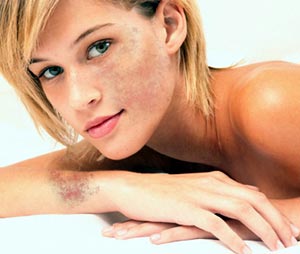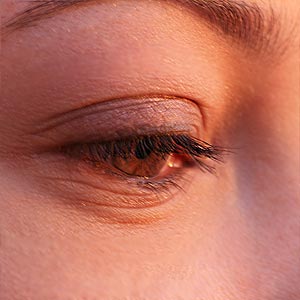Skin Pigmentation

The color of your skin is determined by the melanin or pigment in the skin, be it yellow, dark brown or black. Melanin is responsible for imparting color to your skin, hair and iris of the eyes. Levels of melanin depend on race and amount of sunlight exposure.
Melanin production increases with exposure to the skin so as to protect the skin against harmful ultraviolet rays. A number of women have skin pigmentation problems relating to hormone changes and sun exposure. Read more on skin pigmentation disorders, be it hyper pigmentation or loss of skin pigmentation.
Skin Pigmentation disorder
Skin pigmentation disorders occur as a result of the body producing either too much or too little melanin. Skin pigmentation creates a darker or lighter skin tone that may be blotchy and uneven. Causes of skin pigmentation can range from auto immune conditions to drug reactions or genetic inheritance. Sun damage is probably the leading cause of skin pigmentation problems. Other factors include drug reactions, hormonal changes, genetic factors and medications.
Hormonal therapy, childbirth or birth control pills can cause skin pigmentation changes. Many people suffer from skin pigmentation problems as a result of locally increased skin pigment production. They appear as age spots, moles, liver spots or hyper pigmentation after local skin damage. Freckles are another variation in pigmentation of the skin. They are caused but by uneven release of the pigment.
Hypo pigmentation or loss of skin pigmentation is a condition where the body does not produce sufficient melanin. Sometimes after an ulcer, blister, burn, or infection heals, the skin loses some of its pigment in that area.
Albinism: This leads to a situation of albinism wherein the person has light skin, white or pale yellow hair and gray eyes. Albinism is usually the result of an inherited recessive trait. There is no cure for albinism, and individuals should use a sunscreen at all times because they are much more likely to get sun damage and skin cancer.
Vitiligo: Vitiligo is another form of hypo pigmentation caused by the loss of pigment-producing cells in the skin (melanocytes). These white patches are very sensitive to the sun. This skin pigmentation disorder affects nearly 2% of the population and is more evident in those with darker skin. Some scientists believe Vitiligo may be caused by an autoimmune disorder. It is also linked to hyperthyroidism and Addison's Disease that affects the adrenal glands.
Treatment for Vitiligo involves use of light-sensitive drugs in combination with ultraviolet A treatment. Physicians may prescribe a combination of photosensitive medications like trimethylpsoralen and ultraviolet light therapy to darken the spots affected by Vitiligo. Skin grafting and cosmetic concealers can also be resorted to.
Hyper Pigmentation is a condition where the body produces too much melanin thereby causing to become darker than usual. Hyper pigmentation can occur due to excessive sun bathing or drug reactions. Many a time wounds and scars leave a darker patch of skin. Birthmarks, moles, and aging spots are also indications of hyper pigmentation. It is important to keep on the alert for any change in size, color or texture for indications of skin cancer.
Lichen Simplex Chronicus: This skin pigmentation disorder is characterized by dark patches of skin accompanied with severe itching. This can lead to permanent scarring and infection if untreated.
Melasma: This hyper pigmentation condition is a fallout of pregnancy hormones. A dark mask appears over the cheeks, bridge of the nose and the neck. This dark mask usually disappears after the birth of the child. This skin pigmentation condition is also known as chloasma and can be treated with prescription creams and over-the-counter products.
Birthmarks: This type of skin pigmentation appears at birth or in the few weeks following birth. These birthmarks do not generally pose any health risks.
Port-wine Stains: These skin pigmentation spots are caused by abnormal development of capillaries and appear as a red or purple mark on the body.
Skin Pigmentation Remedy
A dermatologist will help in identifying the skin pigmentation condition with a visual examination and simple tests. Most often skin pigmentation affects only the outward appearance and is not indicative of any underlying health risks. Sometimes a biopsy is done of the affected area to rule out any cancerous growth. Most often people affected by skin pigmentation disorders use sunscreen and avoid excessive sun exposure. Skin-lightening creams are available for hyper pigmentation disorders.
Hydroquinone is widely used to block formation of new melanin. Retin-A is also prescribed to counter the effects of hyper pigmentation. Topical steroid creams can help alleviate itching associated with some form of skin pigmentation. Cosmetic procedures like glycolic acid peels help in improving the effectiveness of the bleaching agents. Skillfully applied makeup can help in covering affected areas of the skin. Hypoallergenic cosmetics can be used to cover uneven and blotchy skin.
Top of the Page: Skin Pigmentation
Tags:#skin pigmentation #loss of skin pigmentation #skin pigmenation disorder
 Beauty
Beauty Facial Skin Care
Skin Care Essentials
Men's Skin Care
Beauty Control - Sunscreen
Sunburn Remedies
Natural Sunblock
Beauty Care Routine
Skincare Tips for Teens
Dry Skin Care
Asian Skin Care
Black Skin Care
Pregnancy Skin Care Tips
Oily Skin Care
Skincare For Aging Skin
Common Skin Problems
 Crow's Feet
Crow's Feet Hyperpigmentation
Melasma
Acne during Pregnancy
Back and Chest Acne
Adult Acne in Women
Excessive Sweating
Whiteheads
Cause Dark Eye Circle
Chapped Lips
Age Spot
Skin Cancer Symptom
Skin Care Treatments
 Chemical Skin Peels
Chemical Skin Peels Radio Frequency Skin Tightening
Electroporation Beauty Treatment
Home Remedies for Large Pores
Dermaplaning Benefits
Manuka Oil Benefits
Skin Needling
Cheek Fillers
Cosmetic Dermal Filler
Skin Lightening
Skin Exfoliation
Bamboo Massage
Dry Skin Brushing
Stretch Mark Removal
Freckle Removal
Rosacea Treatment
Skin Care Routine
Tretinoin Cream Benefits
Alpha Hydroxy Acid
Homemade Face Mask
Bath Salt Recipe
Tea Tree Oil
Wrinkle Cream
Almond oil Benefits
Jojoba Oil
Handmade Soap
Eye Creams
Facial Cleanser
Botox Cosmetic
Benefit of Aloe Vera
Shea Butter Benefit
Top of the Page: Skin Pigmentation
Popularity Index: 100,870

